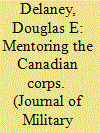| Srl | Item |
| 1 |
ID:
123604


|
|
|
|
|
| Publication |
2013.
|
| Summary/Abstract |
The Canadian Corps of 1918 was not an entirely self-made machine. It needed outside help to develop into the highly effective fighting formation that it became by war's end. Between 1914 and 1918, the British Army sent scores of officers to Canadian formations, to make up key command and staff deficiencies in the Canadian Expeditionary Force and to train selected officers to take their places. Canadian political pressure ensured that these replacements were Canadian. The product of this somewhat ad hoc mentoring process was a Canadian Corps, commanded and staffed almost entirely by Canadian officers, that could keep pace with any British Expeditionary Force formation on the Western Front.
|
|
|
|
|
|
|
|
|
|
|
|
|
|
|
|
| 2 |
ID:
151466


|
|
|
|
|
| Summary/Abstract |
The Commonwealth assaults against German forces on the western front during 1917 include several famous disasters and successes. Perhaps the least known of these successes is the battle of Hill 70 of August 1917, in which the Canadian Corps seized a powerful German position, inflicted disproportionate and heavy losses on the defenders, and achieved their strategic objective of pinning German forces away from the campaign in Flanders. This success occurred because the Canadian Corps developed a sophisticated and powerful system for set piece battles, in which intelligence played a key role. This article assesses how intelligence affected all aspects of this battle – from national and theatre level decision-making, down to the dissemination of information to individual soldiers. It demonstrates how intelligence worked in tactical and operational terms on the western front in 1917, and shaped battles.
|
|
|
|
|
|
|
|
|
|
|
|
|
|
|
|